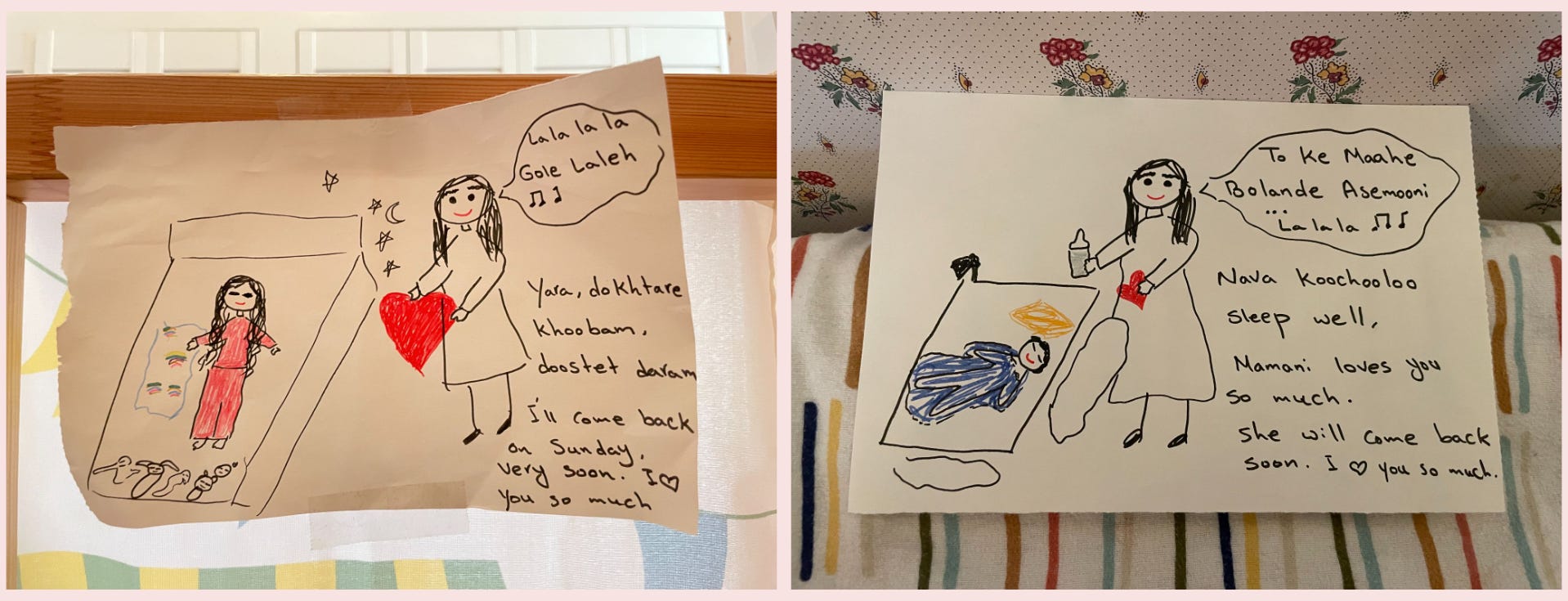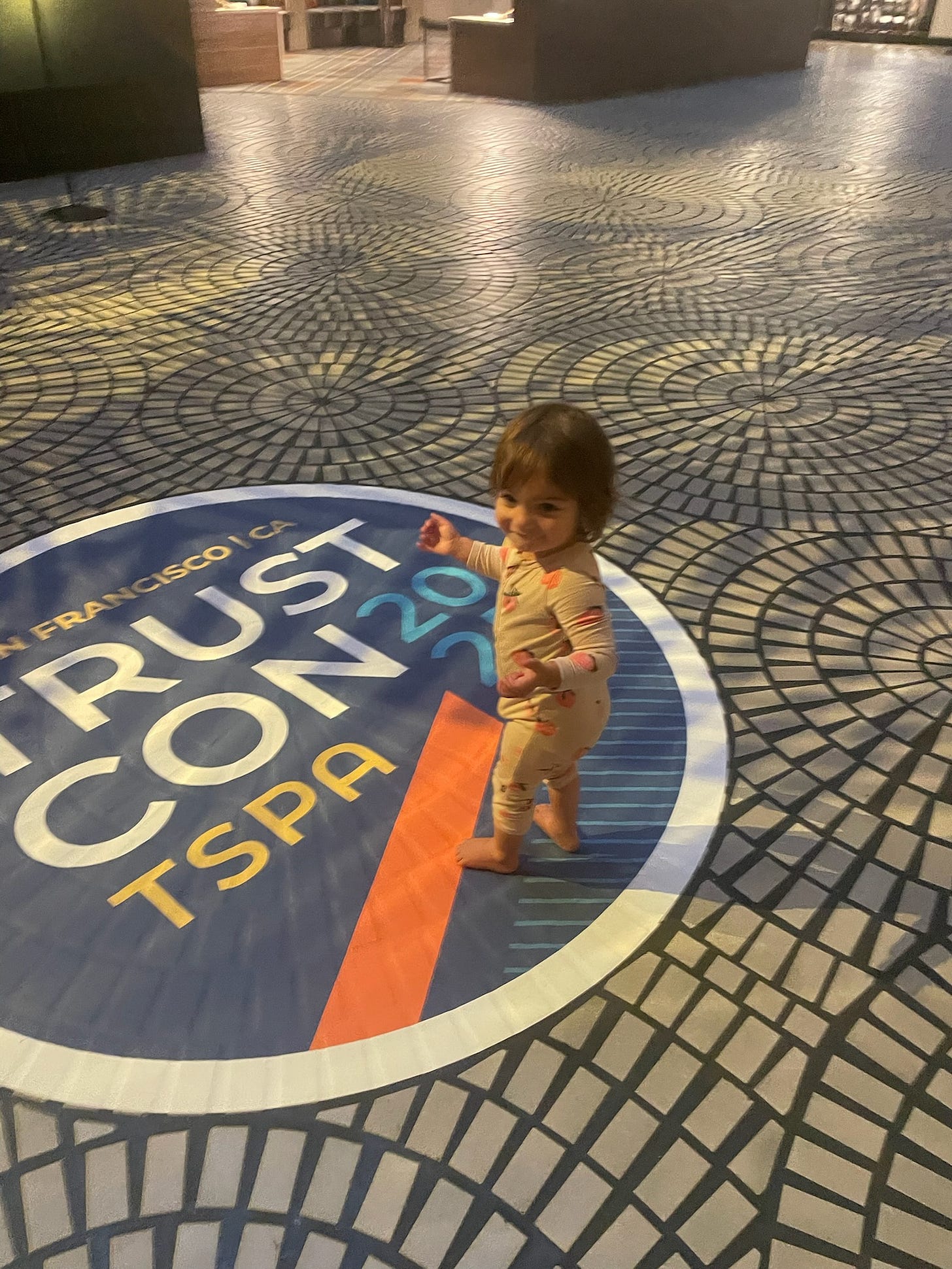"Bring Your Whole Self" - Unless You Have a Toddler
A Guide for Conference Organizers to Better Support Working Parents
First, a quick note to my readers: You subscribed to this newsletter for content on the societal and human rights impacts of AI. While this post might seem off-topic, it is related. Many of us working in AI, tech policy, digital rights, and adjacent fields consider conferences and in-person networking important to our professional development. So I hope you’ll read (or at least skim!) the recommendations, and share them, or keep them in mind the next time you’re planning or attending a conference.
If you're a parent — especially a parent of young children, and especially a mother—you probably know what it feels like to leave a piece of your heart at home when traveling for work. You know the mental gymnastics: Will FaceTime help or just make them sad? Should I check the baby monitor to catch a glimpse of them asleep? Don’t forget to bring back those stickers and conference swag or even your conference badge to put on their little necks and play a conference-play. You count the number of missed bedtimes again and again, prepare in advance, organize playdates to keep them busy while you are gone, pay extra for babysitters or extended preschool hours.

💡 But wait — maybe there’s an alternative!
If the conference is in a nice location, especially during summer, why not turning it into a family trip? Genius idea, right? That’s exactly what I did last week. And that’s what I regret. And that’s why I’m writing this post!
This isn’t an angry rant or an attack on any specific conference organizer or sponsor (I already got that out of my system on BlueSky). Instead, it’s a practical reflection with suggestions for how conferences can better support working parents, especially mothers. Mothers of young children who constantly bend over backward, caught in the expectation (from both society and themselves) to be everything at once: a loving, present caregiver and a successful, fulfilled professional, navigating the myth of equal partnerships, shoulder the weight of emotional labor, and face the pressure of performative parenting — where Instagram moms with five perfectly dressed, laughing children in spotless white-and-beige homes (while homeschooling, of course) set impossibly high standards. All while battling outdated gender norms, only to realize, again and again and again, that so little has truly changed.
I’m also writing this because I’ve noticed that many conferences, especially in the US, rarely go beyond offering a nursing or pumping room, then congratulate themselves with a pat on the back, as if to say, Look how inclusive we are 🎖️
Recommendations for Conference Organizers and Fellow Parents
📝 Registration Forms
If your conference has a accessibility/DEI committee, please include childcare and parental needs as part of your accessibility planning. Trust me, if you can accommodate 100 different dietary restrictions and preferences in the registration form, you can include a simple checkbox or question about childcare needs.
And to fellow parents: don’t be like me — fill in the childcare/accessibility section when registering. I regret not doing it.
💰 Travel Support and Funding
If you offer travel support or are reaching out to sponsors, include childcare funding in your budget requests and make it part of your eligibility for reimbursement.
🪪 Badge Policy and Policing
Parents who travel to conferences with kids often bring partners, grandparents, nannies, or babysitters to help with childcare. Sometimes — because of the unpredictable world of babies and toddlers — they may need to bring the child to the attending parent. That happened to my husband, who was questioned a couple of times when he *had to* bring our children to me in a designated conference area.
Conferences already use color-coded badges and lanyards to indicate roles. So why not create caregiver or accompanying guest badges? Ask during registration if the attendee needs a badge for a caregiver, and include the caregiver’s name. It’s a small step that can help avoid unnecessary policing and unwelcoming encounters.

🍷🛳️ Happy Hours (aka the Witching Hour)
Conference happy hours, Birds of a Feather events, and sponsor mixers usually fall between 5 to 8 PM — the most chaotic time of day for any parent of young kids. I understand the expectation that we keep things professional and avoid bringing children to conference sessions during normal business hours. But after 5 PM is not business hours and let’s be honest: the most fruitful schmoozing —leading to fundraising, new collaborations, and lasting connections — often happens during after-hours events like these. And yet, for attending parents, it’s also the hardest time to justify leaving their kids behind.
🔈 A note to sponsors: Host at least one kid-inclusive happy hour. At the conference I attended recently, there were so many overlapping networking events, it was hard to choose where to go. Why not make one of them a family-friendly mixer? It would make a huge difference. I promise, we can still network and build meaningful connections. Let attending parents bring their kids, meet each other’s families —maybe even meet the little voices colleagues hear in the background of Zoom calls —and connect on a more human level.
⚖️ Oh yeah, what about liability?!
If you can handle serving alcohol at happy hours right up until someone breaks a wine glass or taking attendees on sunset cruises with drinks and hors d’oeuvres, you can figure this out too. Work with your legal team, get a waiver, partner with licensed childcare providers — it can be possible if you want to.
🧸 Lounge or Kid-Friendly Space
Conferences dedicate a lot of space to coffee corners and networking lounges. What if just one small area had a playpen and a few toys (available for cheap everywhere)? Somewhere parents can briefly reconnect with their children between sessions if they need to. Parents attending multi-day, 12-hour events still have 24/7 responsibilities. Offering a small family-friendly area could make a difference.
Kudos to conferences like ACM FAccT, which provide on-site childcare, and to the organizers, who were incredibly thoughtful about these things.
That’s all from me — for now. Thank you for reading. I’m sure many of you have additional suggestions. Let me know and I’ll update the post.
I don’t usually ask people to share my work, but please do this time. I’m not great at marketing myself — which is part of why attending conferences is already a pain and stretch outside my cozy comfort zone. And when the experience becomes unproductive or alienating, it really stings. So please, share this with conference organizers or keep it in mind when you’re planning one.
👩🏻💻 On a work note: I’m currently deeply (and happily) focused on developing an evaluation platform to detect, document, and benchmark multilingual inconsistencies in large language models — particularly in humanitarian contexts and with human rights implications. I’ll share more updates in upcoming issues of this newsletter or when I see you at Stanford’s Trust & Safety Research Conference and MozFest (rpakzad@taraazresearch.org).
This post was partially proofread by OpenAI GPT 4o

